手塚愛子 TEZUKA Aiko
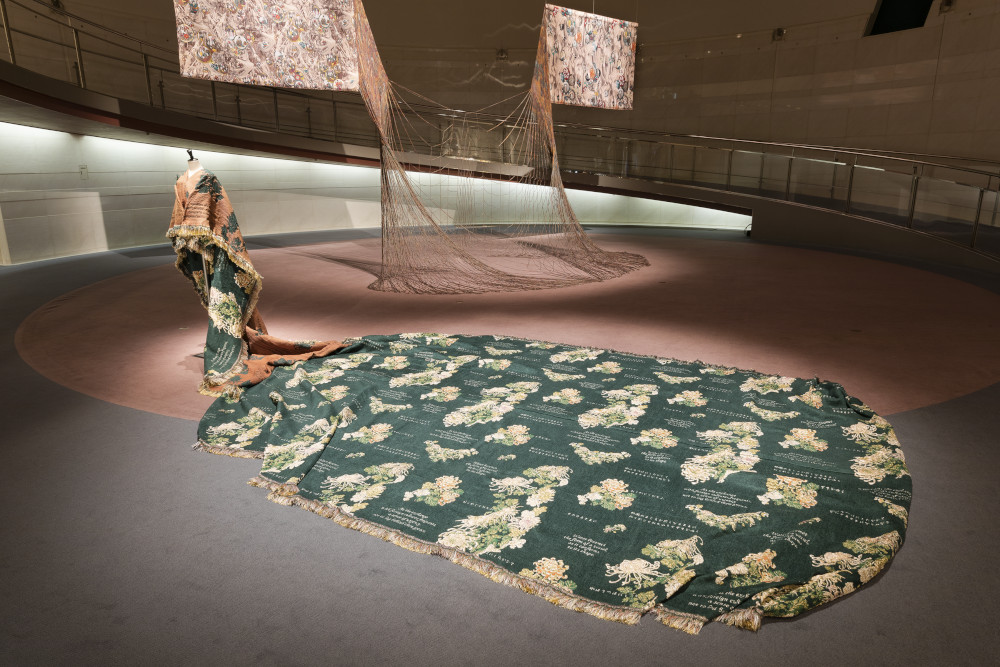
《親愛なる忘却へ(美子皇后について)-01》 2019年
ジャカード織(作家によるデザイン、多色の縦糸、アクリル、綿)173×550×320 cm 織物制作:織物博物館(ティルブルフ、オランダ) 織物制作担当者:ジュディス・ペスケンス(織物博物館、ティルブルフ、オランダ)縫製仕様:奥山陽太、久保南子 協力:共立女子大学博物館 「Dear Oblivion – 親愛なる忘却へ」スパイラル(東京)、2019年の展示 撮影:山中慎太郎 (Qsyum!)
Dear Oblivion (A Study of Empress Haruko) – 01 , 2019
Jacquard weaving designed by the artist with coloured warp threads (materials of the threads are acrylic, cotton) 173×550×320 cm Fabric development and production by TextielMuseum | TextielLab – Tilburg, the Netherlands, product developer is Judith Peskens (TextielMuseum | TextielLab), Tailor work by OKUYAMA Yota, KUBO Minako , Production support by Kyoritsu Women’s University Museum, Exhibited at Dear Oblivion – 親愛なる忘却へ, Spiral, Tokyo, Japan, 2019, Photo by YAMANAKA Shintaro (Qsyum!)
手塚愛子
1976年、東京生まれ。ベルリン、ドイツに在住、ベルリン、東京で活動。
2001年武蔵野美術大学大学院造形研究科美術専攻油絵コース修了(戸谷成雄氏に師事)。2005年京都市立芸術大学大学院油画領域博士(後期)課程修了(宇佐美圭司氏に師事)。2010年五島記念文化賞美術新人賞により渡英。その後文化庁新進芸術家海外研修制度により渡独。織られたものを解きほぐす作品を1997年より開始し、歴史上の造形物を引用、編集しながら新たな構造体を作り出す、独自の手法により制作を続ける。近年の展覧会は東京都現代美術館、福岡市美術館、国立新美術館、兵庫県立美術館、豊田市美術館、テキスタイル博物館(オランダ)、ヨハン・ヤコブ美術館(スイス)、韓国国立現代美術館(ソウル)、アヤラ美術館(フィリピン)、ターナー・コンテンポラリー現代美術館(イギリス)、ベルリンアジア美術館(ドイツ)、ハンブルク美術工芸博物館(ドイツ)、マンハイム美術館(ドイツ)などにて多数。
Born in Tokyo, Japan in 1976. Lives in Berlin, Germany. Mainly active in Berlin and Tokyo.
In 2001, completed the Master’s Degree programme in Painting at Musashino Art University, Tokyo (studied under sculptor Toya Shigeo). In 2005, completed PhD in Painting at the Art Research Department of Kyoto City University of Arts, Kyoto, Japan (studied under painter Usami Keiji). From 2010 to 2011, lived and worked in London, UK, supported by the Gotoh Memorial Cultural Foundation. Then began to live in Berlin (2011), with the support of a fellowship from the Japanese Government’s Overseas Study Program for Artists. In 1997, embarked on a type of work that unravels readymade fabric. Has continued to create new structural forms through referring to and editing historical objects, using unique methods of her own. Recent exhibitions: The Museum of Contemporary Art Tokyo; Fukuoka Art Museum; The National Art Center, Tokyo; Hyogo Prefectural Museum of Art; Toyota Municipal Museum of Art; TextielMuseum (Netherlands); Johann Jacobs Museum (Switzerland); National Museum of Modern and Contemporary Art Korea (Seoul, Korea); Ayala Museum (Philippines); Turner Contemporary (UK); Museum of Asian Art (Berlin, Germany): Museum für Kunst und Gewerbe Hamburg (Germany); Kunsthalle Mannheim (Germany); and many others.
更新された最新の情報は、作家のウェブサイトとSNSをご覧ください。
Please refer to the following artist’s website and social media pages for new updates.
http://aikotezuka.com/
https://www.instagram.com/aikotezuka/

《必要性と振る舞い(薩摩ボタンへの考察)-02》 2019年
ジャカード織(作家によるデザイン、多色の縦糸、アクリル、綿)インスタレーション 320×735×325 cm、(Kunsthalle Mannheim、2021年のインスタレーション、360 ×570 ×320 cm) 織物制作:織物博物館(ティルブルフ、オランダ)織物制作担当者:ジュディス・ペスケンス(織物博物館、ティルブルフ、オランダ)協力:KCI 公益財団法人 京都服飾文化研究財団 「Dear Oblivion – 親愛なる忘却へ」ギャラリー・ミヒャエル・ヤンセン、ベルリン、ドイツ、2019年の展示 撮影:レプコウスキー・スタジオ、ベルリン
A Study of Necessity (Satsuma-Buttons and Self-Orientalism) – 02 , 2019
Jacquard weaving designed by the artist with coloured warp threads (materials of the threads are acrylic, cotton) 320×735×325 cm (installation), 360×570×320 cm (installation in Kunsthalle Mannheim in 2021) Fabric development and production by TextielMuseum | TextielLab – Tilburg, the Netherlands, product developer is Judith Peskens (TextielMuseum | TextielLab) Production support by KCI (The Kyoto Costume Institute, Japan) Exhibited at Dear Oblivion – 親愛なる忘却へ, Galerie Michael Janssen, Berlin, Germany, 2019 Photo by Lepkowski Studios, Berlin
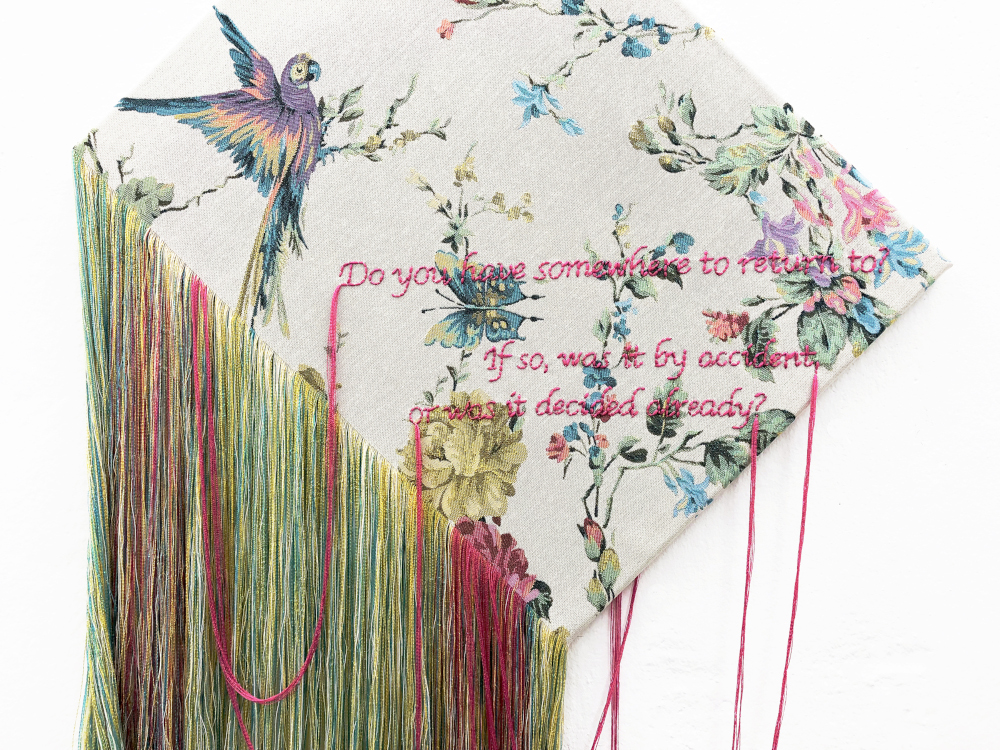
《Mutterkuchen – 01「あなたに帰る場所はありますか、もしそうなら、それは偶然?それとも必然?」》2018年
既製品の織物を解いて編んだ籠と刺繍 155×70 cm(木枠サイズ 55 ×42 cm)
Mutterkuchen – 01, 2018
Embroidery and a knitted basket with unravelled readymade fabric, wooden frame 155×70 cm (frame size 55×42 cm)
この作品を作るきっかけになったのは、ドイツの滞在許可(ビザ)を取るために2-3年ごとに行かなければならない外国人局での体験です。外国人局の職員の大多数はドイツ人ですが、「良い担当者に当たるかどうか」は私たち移民の間では毎回ちょっとしたトピックです。もしも「悪い担当者」に当たった場合、ドアを開いて部屋に入った瞬間に彼らから私たちに向けられる視線や、ぶっきらぼうな言い方での質問などで、彼らが私を見下しているのがすぐに分かります。私はドイツのビザを取りに来ているわけですから、そこでは行儀良く振舞います。けれど同時に心の中では、「あなたがドイツに生まれたのは、あなたが選んだことでしょうか」という問いが生まれます。
当然のことながら、国籍を選んで生まれてきた人はこの世に誰一人いないはずなのですが、その「当然のこと」が社会に浸透することは難しく、国籍によって人を差別することは根強く、現実的に存在しています。私は自分自身が移民としてドイツで生活するなかで、差別を受ける側の経験を何度もしましたが、心が傷つくと共に、自分にも誰かを差別する視線がないとは言えないことも含め、この課題は非常に現代的な問題をはらんでいると考えるようになりました。
作品の構造的には、織物を解いた糸を再び束に分けて、その束で籠を編んでいます。自らの体が解体し、それが再び構造体になり、流れ出す体液を受け止めるような構造を、それら全てが繋がる形で作りたいと思いました。解かれた糸の一部によって、「あなたに帰る場所はありますか、もしそうなら、それは偶然?それとも必然?」という文字列が刺繍されています。解かれた体の一部が、再び自身の体に聞き返すように。
I was motivated to produce this work from my experiences visiting the Alien Registration Office in Germany, in order to acquire a residence permit/visa every two or three years. The majority of the staff working there were Germans; thus, whether we immigrants were “appointed to a nice person or not” became something of a topic among us. When we had “a bad staff,” we could instantly tell that they looked down on us, from their gazes on us the moment we opened the door and walked into the room, and how they questioned us in a gruff tone of voice. Since my visit to the office was to acquire a German visa, I behaved appropriately while I was there. But at the same time, the question that came into mind was, “Was it your choice to be born in Germany?”
Needless to say, not a single person in this world chose to be born into a certain nationality. But this “obvious fact” is difficult to penetrate society. Thus, acts of discrimination based on nationality still strongly exist in real life. Living in Germany as an immigrant myself, I have had quite a few experiences of being discriminated against. It hurt every time, but it also led me to become aware that this subject keenly involves many of today’s social problems, including the fact that I myself could also turn a discriminating eye on someone.
Structurally, in this work, the unravelled pieces of thread were divided into bundles, and then knitted into a basket form. I wanted to create a form that could connect all elements. That is to say, my aim was to produce a structure in which its own body is dismantled, and then for it to once again have a structural body that can accept the “body fluid” that seeps out. A segment of the unravelled thread was used to embroider the text, “Did you choose your place of birth, or was it decided for you?” This is as if a part of the dismantled body was once again posing a question to its own body.
(Translated by NANPEI Taeko)
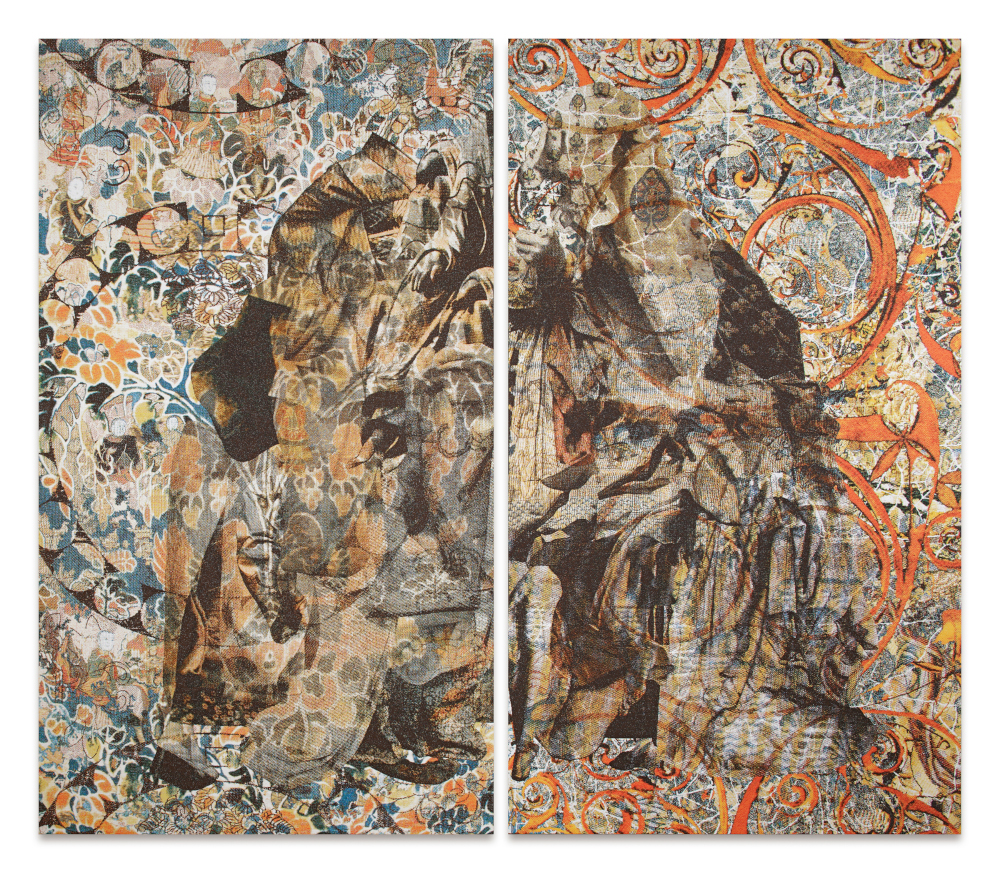
《Ghost I met》2013年
多色織(EPOTEX) 330×385cm(2点組)、各パネルサイズ 330 ×190cm 制作協力:川島織物セルコン 撮影:レプコウスキー・スタジオ、ベルリン
Ghost I met , 2013
Multicolor Weaving “EPOTEX” 330×385 cm (installation), 330×190 cm (each), set of two Fabric development and production by Kawashima Selkon Textiles Co.,Ltd Product developer is WAKITA Tsunehiro (Kawashima Selkon) Photo by Lepkowski Studios, Berlin
左パネルのモチーフは全て日本の造形物から集められ、一方、右パネルのそれはヨーロッパ大陸から集められています。日本のものは、古代の刺繍から仏像、染物、着物や能装束、普段着などから集められました。ヨーロッパ大陸のものは、古代エジプトのコプトの衣服、ギリシャ彫刻、17世紀の油彩の絵画、イギリスの刺繍、イタリアの彫刻、18~19世紀の女性のドレスなどです。日本のものとヨーロッパのもの、特に装飾は、一見異なるものに見えても、よく見ていくと驚くほどの相似性があります。おそらく、シルクロードやその他の道を通り日本に伝わったためでしょう。これらのモチーフはその相似性を意識して集められました。
これらたくさんのモチーフは何層にも重ねられていますが、ところどころが意図的にくり抜かれているために、最下層から表面までを貫通して見ることが出来るようになっています。
左パネルと右パネルを横断するように、半透明の大きな「幽霊」が中央に鎮座し、その体は中心で引き裂かれています。おそらくこの「幽霊」は私自身でしょう。この作品を作った当時、私は日本とヨーロッパ文化の違いに直面していました。しかし同時に、私は「純粋な」日本というものを知らない、とも思っていました。私が生まれた日本は不運にも、すでにヨーロッパあるいはアメリカに十分に影響を受けたものになっていました。このことから私は、様々な層の間で彷徨う、半透明の幽霊を作ろうと思いました。
The work consists of two large panels, and a translucent large ghost is standing in the centre of the two panels. All the motifs on the left panel are inspired by Japanese cultural references such as ancient embroidery in the 7th century, fabrics and silk shoes in the 8th century, a Buddha statue in the 13th century, Kimonos in the 17th – 20th century and daily-use clothing in the 19th century. On the other hand, all the motifs on the right panel are inspired by European culture such as ancient Greek statues, ancient Coptic clothing in the 7-10th century, Celtic patterns in the 7th century, paintings in France and Spain in the 16-18th century, Italian lace in the 17th century, English embroidery in the 17th century, Italian sculptures in the 17th century, women’s dresses in the 18-19th century. Motifs found both on the left and right are collected according to their similarities. The varying motifs create many layers and they can be found all across the fabric as the layers are juxtaposed. The translucent ghost is perhaps my self-portrait who is torn between Japan and Europe. When I made this work I was facing the difference between Japanese and European cultures. Gradually, I felt that I could no longer say that I was “pure” Japanese because I grew unable to articulate what “pure” Japan is like. “Japan” has been changing, increasingly “Europeanized” and “Americanized”, perhaps more rapidly than when I was born. Therefore, projecting myself onto the ghost, the translucent ghost appears between the layers.
より詳細な説明は、作家のウェブサイトを参照:http://aikotezuka.com/ja/ghost-i-met/
Please refer to the artist’s website for more detailed information : http://aikotezuka.com/ghost-i-met/
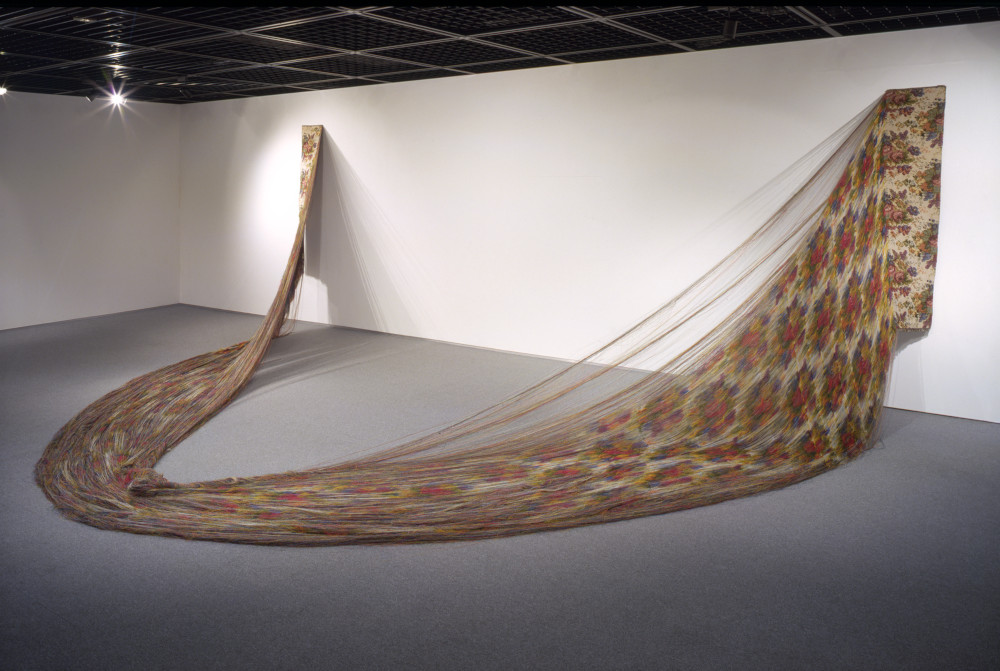
《弛緩する織物》 2005年
解体された織物 200×700 ×300 cm(インスタレーションサイズ)、155×1100 cm(織物) 展示:「『森』としての絵画:『絵』のなかで考える」岡崎市美術博物館(愛知)2007年 岡崎市美術博物館蔵 撮影:柳場大
Loosening Fabric , 2005
Unravelled fabric 200×700 ×300 cm (installation size), 155 x 1100 cm (fabric) Exhibited at Painting as Forest: Artist as Thinker, Okazaki Mindscape Museum, Aichi, Japan, 2007 Collection of Okazaki Mindscape Museum, Aichi, Japan Photo by YANAGIBA Masaru
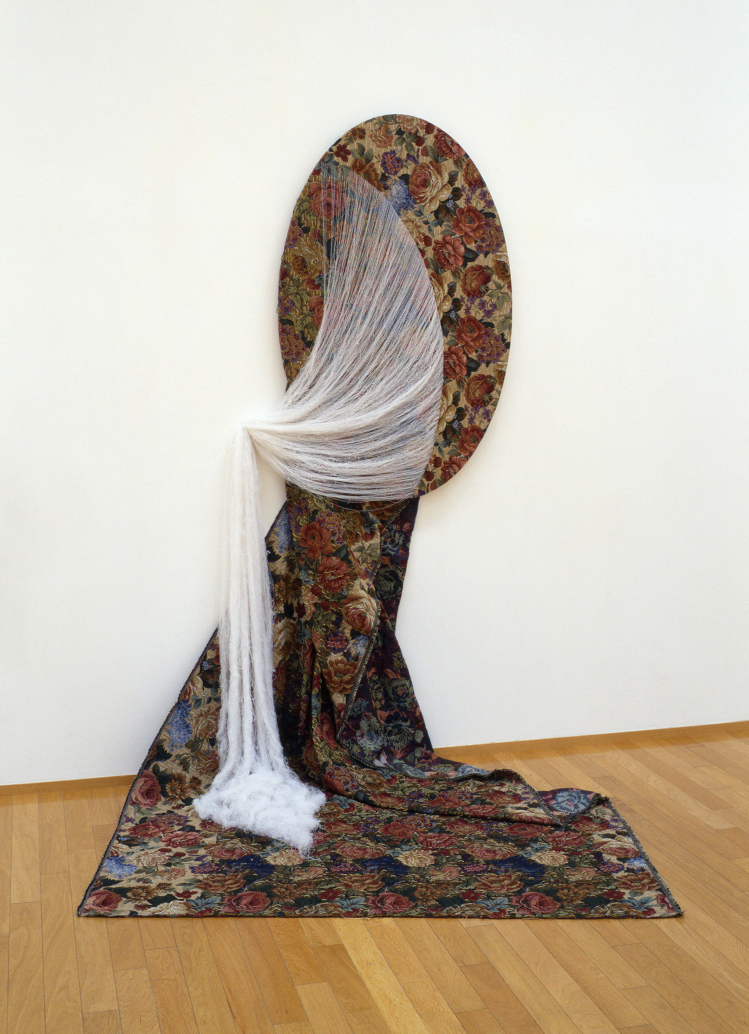
《経糸を引き抜く 新しい量として》 2003年
引き抜いた縦糸、織物、パネル 228× 162×135 cm(インスタレーションサイズ)、140×80 cm(楕円形パネル)、400×150 cm(織物)豊田市美術館蔵 撮影:福永一夫
Extracting Warp Threads to Create a New Quantity , 2003
Extracted warp threads, fabric, wooden panel 228×162×135 cm (installation size), 140×80 cm (oval panel), 150×400 cm (fabric) Collection of the Toyota Municipal Museum of Art, Aichi, Japan Photo by FUKUNAGA Kazuo
4メートル近い白い糸が、クラシックな色調の織物から引き出されていて、それはまるで清水のように見えます。観者は、床に敷かれている部分の布に、色が変わっている部分を見つけるでしょう。その境界線は、白い糸が入っている部分と入っていない部分です。布の端から、針を使って一本一本白い糸だけを引き抜き、楕円形パネルの上の線で止めています。この白い糸が未だ元の織物と繋がっていることが私には重要です。何故なら、どちらがオリジナルでどちらが帰属するものなのか、良くわからないような状況を作り出したかったからです。元の織物と引き出された白い糸は、それぞれ独立したもののように見えますが、未だ大本は繋がっていることを見せています。
White threads, nearly 4 meters in length, are extracted from a classically toned elegant fabric, looking as if spring water is pouring out. The viewers would find that the part of the fabric on the floor looks slightly darker because white threads are pulled out from that section. The white threads are extracted, one by one, using a needle from the edge of the fabric up to the outline of the oval shaped panel. It is crucial that the white threads are still connected to the original fabric because I intended to blur the distinction between what is original and its derivative. The original fabric and the thick bundle of the extracted white threads seem to be separated and yet still connected with each other.

